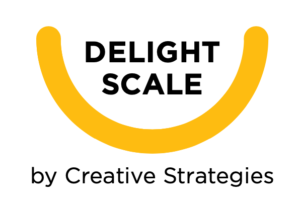Why Use The Delight Scale?
Whether we look at the consumer market or the enterprise market, we are witnessing a transition from hardware, software, and service as an individual source of value to the experience value that arises from their combination. As hardware, software and services work together to deliver value. It is about the overarching experience a user receives that distinguishes a good product and a great product. Understanding how the different parts of the offering or even the different features of one component contribute to the overall experience provides valuable insights into engagement and loyalty and ultimately into the competitive advantage or weakness a product has.
Net Promoter Score (NPS) is a measure that has grown in popularity over the years, especially for products, like smartphones and PCs, where market saturation made market share less effective from a marketing perspective. NPS lets a business categorize its customers based on whether they would promote their product by referral. The NPS score is calculated by considering the number of promoters, detractors and passive customers. This measure provides a quick and easy snapshot of how your customer base feels about your brand or product at a point in time. Yet, the very simplicity that made NPS popular proves to be the biggest weakness, especially as we move towards experience-driven products. This is because NPS tells you how your customers feel but not why. NPS’s critics are mostly dissatisfied with its failure to predict loyalty behaviors such as repurchase. NPS is attitudinal rather than behavioral, meaning it focuses on what you say you will do rather than what you do. Satisfaction has proven to be a better predictor of recommendations. Lastly, NPS is not a composite index, but rather it is based on a straightforward question.
Considering all the criticism, it is easy to see how NPS can be helpful in the assessment of customer satisfaction and loyalty. Still, it should not be used as the only metric of customer loyalty.
Another prevalent measure used by brands is Customer Satisfaction (CSAT). Customer satisfaction is precisely what it says on the box: a measurement that determines how happy customers are with a company’s products, services, and capabilities. Some people say it is a measurement that determines how products or services provided by a company meet customers’ expectations. However, the question asked does not always refer to initial expectations, making this definition of CSAT debatable. In addition, CSAT is different from Customer Loyalty which measures customers’ involvement over time rather than at one point in time. Yet, there is a correlation between CSAT and churn, most likely why some people think that customer satisfaction and loyalty are the same. This is also why CSAT is a poor predictor of future customer behavior.


The Delight Scale utilizes questions with a 7-point satisfaction scale that ranges from one extreme attitude to another with one neutral option. The Likert Scale is a popular and well-known question format used to measure opinions and behavior. Likert-type questions provide more granular feedback about a product compared to binary questions with their two answer options.
The maximum Delight Score a product or service can achieve is 1200. In order to achieve such a score, respondents would have to select the top 2 boxes for all the scoring questions. Rather than allocating a score to all possible answers, the Delight Score uses a Top 2 Box score (sometimes called T2B) in the way of summarizing the positive responses from a Likert Scale. The Top 2 Box score technique is used across research to help with ad testing, product development and brand tracking. This approach has proven to lead to a much more holistic measurement of customer experience, actionable product insights to truly separate great products from average ones. Selecting the top 2 boxes for 60% of the questions would place a product or a service on a Delight Score of around 700.
Product marketing and product planning can rely on this new measure and the insights it provides to understand better their products and the effectiveness of their positioning and advertising, and how their products stuck up against the competition.
While the usefulness of the Delight Scale is apparent in a consumer environment, we designed it with versatility in mind so it can be used in an enterprise context. As digital transformation accelerates, user’s reliance on technology grows, and so does the need to measure how satisfied employees are with the tools they are given to perform their job. While the measure available to consumer market brands to measure product experience could have been better, at least they targeted the right people and provided some albeit limited insights. The enterprise market has had very little over the years, and mostly what has been available focused on the chooser of the technology products rather than the users. Basically, any measure focused on the IT manager’s satisfaction rather than the user’s. The current trend highlighting the importance of employee’s experience and engagement is shifting the priority from the chooser to the user opening the doors for the Delight Scale to make a difference.
Wouldn’t you rather be delighted than just satisfied? So why settle for your products to only deliver satisfaction? The Delight Scale is the product experience measurement reimagined that will help you set your products apart from the rest.